后接动名不定式的动词
- 格式:doc
- 大小:31.50 KB
- 文档页数:4
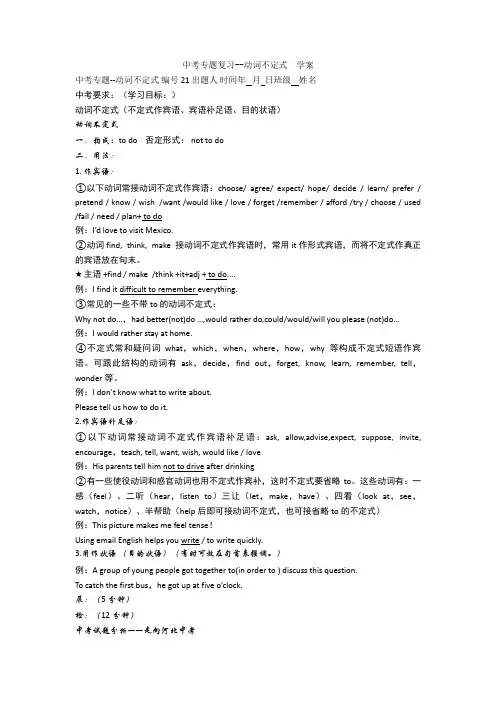
中考专题复习--动词不定式学案中考专题--动词不定式编号21 出题人时间年月日班级姓名中考要求:(学习目标:)动词不定式(不定式作宾语、宾语补足语、目的状语)动词不定式一.构成:to do 否定形式: not to do二.用法:1. 作宾语:①以下动词常接动词不定式作宾语:choose/ agree/ expect/ hope/ decide / learn/ prefer / pretend / know / wish /want /would like / love / forget /remember / afford /try / choose / used /fail / need / plan+ to do例:I’d love to visit Mexico.②动词find, think, make 接动词不定式作宾语时,常用it作形式宾语,而将不定式作真正的宾语放在句末。
★主语 +find / make /think +it+adj + to do....例:I find it difficult to remember everything.③常见的一些不带to 的动词不定式:Why not do…,had better(not)do …,would rather do,could/would/will you please (not)do…例:I would rather stay at home.④不定式常和疑问词what,which,when,where,how,why等构成不定式短语作宾语。
可跟此结构的动词有ask,decide,find out,forget, know, learn, remember, tell,wonder等。
例:I don’t know what to write about.Please tell us how to do it.2.作宾语补足语:①以下动词常接动词不定式作宾语补足语:ask, allow,advise,expect, suppose, invite, encourage,teach, tell, want, wish, would like / love例:His parents tell him not to drive after drinking②有一些使役动词和感官动词也用不定式作宾补,这时不定式要省略to。
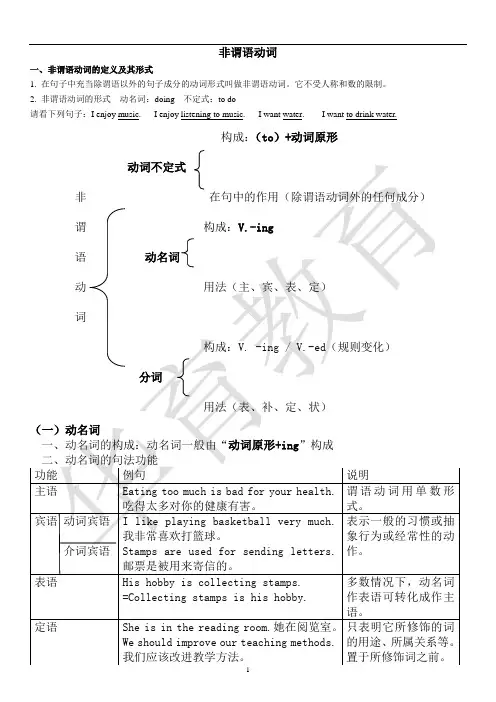
非谓语动词一、非谓语动词的定义及其形式1. 在句子中充当除谓语以外的句子成分的动词形式叫做非谓语动词。
它不受人称和数的限制。
2. 非谓语动词的形式动名词:doing 不定式:to do请看下列句子:I enjoy music. I enjoy listening to music. I want water. I want to drink water.构成:(to)+动词原形动词不定式非在句中的作用(除谓语动词外的任何成分)谓构成:V.-ing语动名词动用法(主、宾、表、定)词构成:V. -ing / V.-ed(规则变化)分词用法(表、补、定、状)(一)动名词一、动名词的构成:动名词一般由“动词原形+ing”构成二、动名词的句法功能功能例句说明主语Eating too much is bad for your health.吃得太多对你的健康有害。
谓语动词用单数形式。
宾语动词宾语介词宾语I like playing basketball very much.我非常喜欢打篮球。
Stamps are used for sending letters.邮票是被用来寄信的。
表示一般的习惯或抽象行为或经常性的动作。
表语His hobby is collecting stamps.=Collecting stamps is his hobby. 多数情况下,动名词作表语可转化成作主语。
定语She is in the reading room.她在阅览室。
We should improve our teaching methods.我们应该改进教学方法。
只表明它所修饰的词的用途、所属关系等。
置于所修饰词之前。
1.动名词作主语动名词作主语相当于一个名词,谓语动词要用第三人称单数形式(1)动名词作主语的句型1)Doing...+ v.Reading is an art.阅读是门艺术。
Seeing is believing.眼见为实。
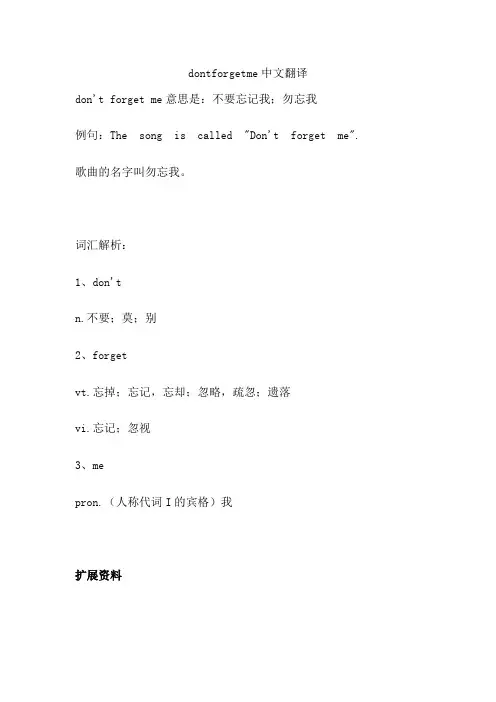
dontforgetme中文翻译
don't forget me意思是:不要忘记我;勿忘我
例句:The song is called "Don't forget me". 歌曲的名字叫勿忘我。
词汇解析:
1、don't
n.不要;莫;别
2、forget
vt.忘掉;忘记,忘却;忽略,疏忽;遗落
vi.忘记;忽视
3、me
pron.(人称代词I的宾格)我
扩展资料
forget的基本含义是“忘,忘记”,指由于记忆上的忽略而对某人或某物失去了印象,这种“忘记”可能只是暂时的,也可能是长久的。
forget还可表示“疏忽,忽略”。
forget可用作及物动词,也可用作不及物动词。
用作及物动词时,后接名词或代词作宾语,也可接动名词、动词不定式或含有疑问词的动词不定式作宾语,还可接由that或疑问词引导的从句作宾语。
可用于被动结构。
词义辨析:forget v-ing, forget to-v
forget后接动名词或动词不定式都表示“忘记”。
其区别是:
1、后接动名词表示“忘记曾经做过或发生的事”(该事已经发生过了)。
He has forgotten paying me. 他忘记钱已经付给我了。
2、后接动词不定式则表示“忘记去做某事”(该事尚未发生)。
He has forgotten to pay me. 他忘记付给我钱了。
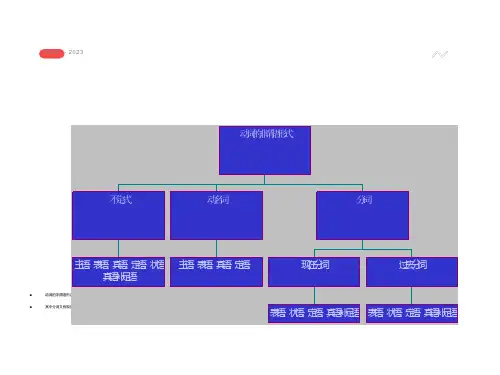
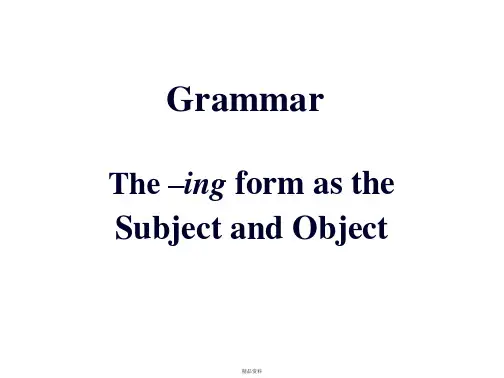
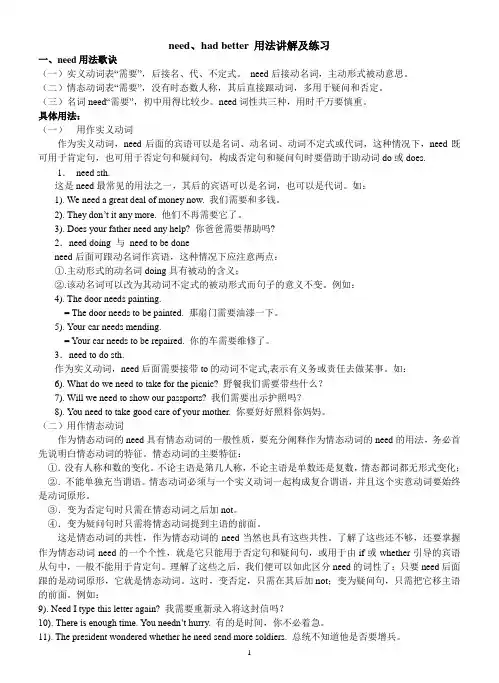
need、had better 用法讲解及练习一、need用法歌诀(一)实义动词表“需要”,后接名、代、不定式。
need后接动名词,主动形式被动意思。
(二)情态动词表“需要”,没有时态数人称,其后直接跟动词,多用于疑问和否定。
(三)名词need“需要”,初中用得比较少。
need词性共三种,用时千万要慎重。
具体用法:(一)用作实义动词作为实义动词,need后面的宾语可以是名词、动名词、动词不定式或代词,这种情况下,need既可用于肯定句,也可用于否定句和疑问句,构成否定句和疑问句时要借助于助动词do或does.1.need sth.这是need最常见的用法之一,其后的宾语可以是名词,也可以是代词。
如:1). We need a great deal of money now. 我们需要和多钱。
2). They don’t it any more. 他们不再需要它了。
3). Does your father need any help? 你爸爸需要帮助吗?2.need doing 与need to be doneneed后面可跟动名词作宾语,这种情况下应注意两点:①.主动形式的动名词doing具有被动的含义;②.该动名词可以改为其动词不定式的被动形式而句子的意义不变。
例如:4). The door needs painting.= The door needs to be painted. 那扇门需要油漆一下。
5). Y our car needs mending.= Y our car needs to be repaired. 你的车需要维修了。
3.need to do sth.作为实义动词,need后面需要接带to的动词不定式,表示有义务或责任去做某事。
如:6). What do we need to take for the picnic? 野餐我们需要带些什么?7). Will we need to show our passports? 我们需要出示护照吗?8). Y ou need to take good care of your mother. 你要好好照料你妈妈。
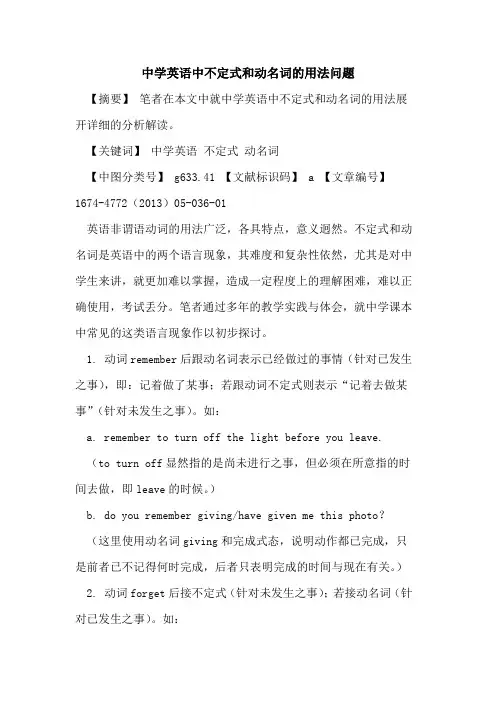
中学英语中不定式和动名词的用法问题【摘要】笔者在本文中就中学英语中不定式和动名词的用法展开详细的分析解读。
【关键词】中学英语不定式动名词【中图分类号】 g633.41 【文献标识码】 a 【文章编号】1674-4772(2013)05-036-01英语非谓语动词的用法广泛,各具特点,意义迥然。
不定式和动名词是英语中的两个语言现象,其难度和复杂性依然,尤其是对中学生来讲,就更加难以掌握,造成一定程度上的理解困难,难以正确使用,考试丢分。
笔者通过多年的教学实践与体会,就中学课本中常见的这类语言现象作以初步探讨。
1. 动词remember后跟动名词表示已经做过的事情(针对已发生之事),即:记着做了某事;若跟动词不定式则表示“记着去做某事”(针对未发生之事)。
如:a. remember to turn off the light before you leave. (to turn off显然指的是尚未进行之事,但必须在所意指的时间去做,即leave的时候。
)b. do you remember giving/have given me this photo?(这里使用动名词giving和完成式态,说明动作都已完成,只是前者已不记得何时完成,后者只表明完成的时间与现在有关。
)2. 动词forget后接不定式(针对未发生之事);若接动名词(针对已发生之事)。
如:c. don’t forget to give me regards to him.(to give显然指的是还未进行之事,但必须去做。
)d. i forgot returning the magazine.(returning说明该动作已经完成,只是何时完成已忘记。
)3. 动词regret 后接不定式(针对未发生之事);接动名词(针对已发生之事)。
如:e. i regret to tell you that we can’t stay here any longer. (动词不定式to tell此动作还未发生,可是还得去做。
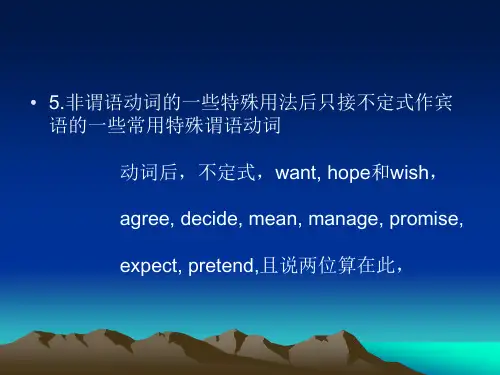
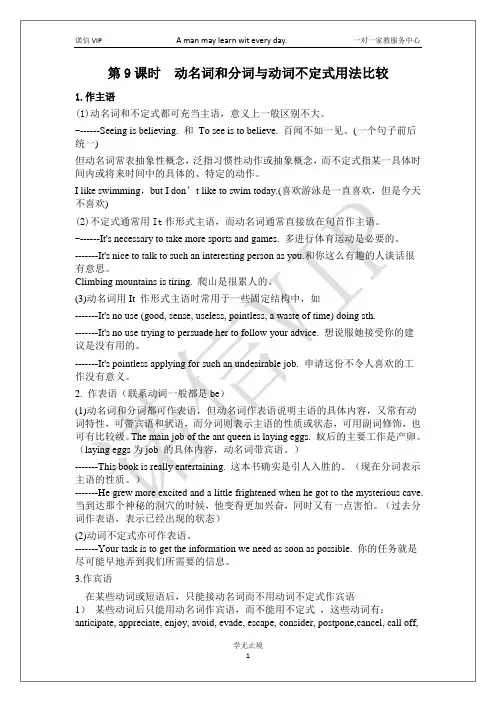

高中英语名师解惑:动词后面,到底是接不定式还是动名词?在学习了不定式和动名词以后,经常有学生问道:“这个动词后面,是接不定式还是动名词??”一般地讲,动词后面接不定式,表示一件具体的事情,或者是还没有做的事情;动词后面接动名词,表示泛指的事情,或者是正在进行的事情。
如果你还在为动词后面到底接不定式还是动名词而发愁?今天这篇内容可一定要认真看了哦!那么,就让我们一起来学习吧!只接不定式(不能接动名词)作宾语的25个常用动词1. want to do sth. 想要做某事I want to buy a new computer this a ernoon.我想今天下午买台新电脑。
2. would like to do sth.想要做某事I would like to invite you to come to my birthday party this Saturday. 我想邀请你这周六来我的聚会。
3. wish to do sth. 希望做某事I wish to live on the moon one day.我希望有一天在月球上生活。
4. help to do sth. 帮助做某事I o en help to do some chores at home.我在家经常帮着做家务。
5. hope to do sth. 希望做某事I hope to have a good rest this weekend.我希望这周末好好休息一下。
6. learn to do sth. 学会做某事He finally learned to play the piano with the help of the teacher. 在老师的帮助下,他最终学会了弹钢琴。
在老师的帮助下,他最终学会了弹钢琴。
7. manage to do sth. 设法做成某事设法做成某事They managed to escape the fire yesterday.昨天他们设法逃脱了火灾。
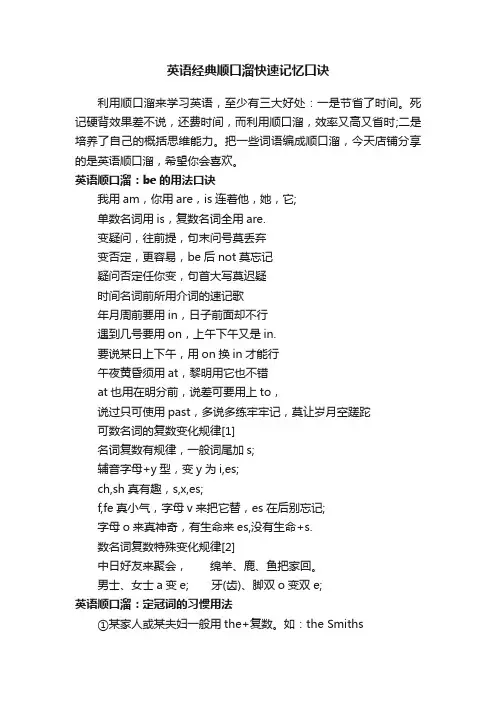
英语经典顺口溜快速记忆口诀利用顺口溜来学习英语,至少有三大好处:一是节省了时间。
死记硬背效果差不说,还费时间,而利用顺口溜,效率又高又省时;二是培养了自己的概括思维能力。
把一些词语编成顺口溜,今天店铺分享的是英语顺口溜,希望你会喜欢。
英语顺口溜:be的用法口诀我用am,你用are,is连着他,她,它;单数名词用is,复数名词全用are.变疑问,往前提,句末问号莫丢弃变否定,更容易,be后not莫忘记疑问否定任你变,句首大写莫迟疑时间名词前所用介词的速记歌年月周前要用in,日子前面却不行遇到几号要用on,上午下午又是in.要说某日上下午,用on换in才能行午夜黄昏须用at,黎明用它也不错at也用在明分前,说差可要用上to,说过只可使用past,多说多练牢牢记,莫让岁月空蹉跎可数名词的复数变化规律[1]名词复数有规律,一般词尾加s;辅音字母+y型,变y为i,es;ch,sh真有趣,s,x,es;f,fe真小气,字母v来把它替,es在后别忘记;字母o来真神奇,有生命来es,没有生命+s.数名词复数特殊变化规律[2]中日好友来聚会,绵羊、鹿、鱼把家回。
男士、女士a变e; 牙(齿)、脚双o变双e;英语顺口溜:定冠词的习惯用法①某家人或某夫妇一般用the+复数。
如:the Smiths②表示整个民族或族人一般加the。
如the Chinese/English③少数山脉群岛也不用the。
如Mount Tai。
如名词中有of短语则一般有the.如:the Mountain of sevensighs. ④中国的湖泊一般加the。
如:the West Lake. R>⑤the+adj表示类别。
如:the rich.⑥年代,年龄的约数前常用the。
如:in the 1950s,in his teens.⑦表计量单位用the含有“每”、“每一”It sells at two dollars the pound. It sells 16 dollars to the pound. John is paid by the hour. ⑧下列结构中的冠词。
初中英语forget 动词辨析
“Forget”是初中英语中一个常用的动词,它有多种用法和含义。
以下是对“forget”这个动词的辨析:
1. 作及物动词,表示“忘记,遗忘”。
例如:
- I forget your name. 我忘记了你的名字。
- He has forgotten how to speak French. 他已经忘记了如何说法语。
2. 后接动名词或不定式,表示“忘记做某事”。
动名词表示已经发生的动作,不定式表示未发生的动作。
例如:
- I forget closing the door. 我忘记已经关了门。
- I forget to close the door. 我忘记去关门了。
3. 接“疑问词+ 不定式”结构,表示“忘记要做什么”。
例如:
- I forget what to do next. 我忘记下一步要做什么。
4. 接从句,表示“忘记……的事”。
例如:
- I'll never forget what you said. 我永远不会忘记你说的话。
5. 用于否定句中,表示“没有忘记”。
例如:
- I haven't forgotten you. 我没有忘记你。
6. 与“about”连用,表示“忘记关于……的事”。
例如:
- I forget about the meeting. 我忘记了关于会议的事。
7. 与“for”连用,表示“因……而忘记”。
例如:
- I forget for the noise. 我因噪音而忘记了。
一.Doing 的用法1.+ doing( 只能加 doing 的 )Like/dislike/enjoy/have fun doing喜做consider doing 考做mind (sb) doing 介意做imagine doing想象做suggest doing 建做practice doing 做finish doing 束做what about/ how about doing sth做某事如何Thank you for doing sth.⋯感某人at the beginning of 的起初;⋯⋯的开始keep/go/ (on) /continue doing持做can’thelp doing 情不自禁做can’tstand doing 不能忍受做feel like doing想要做be busy doing忙于做某事go +doing (go shopping) 去做某事no +doing 禁止做某事be worth doing得做be busy doing sth 忙于做某事can’tstop doing sth 忍不住做某事spend time/money (in) doing花做某事waste time/money (in) doing浪做某事consider doing sth 考做某事have trouble/difficulty/problems/experience (in)doing 做某事有困 /有used to do 去常常做某事be /get used for doing sth = be used to do sth. 被用来作某事be /get/used to doing 于做某事pay attention to doing 注意做某事hold on to doing sth 持做某事 lookforward to doing 期望做某事 beinterested in doing=take an interest in doing--- 感趣be good at doing sth= do well in doing sth.擅作某事about: be worried about doing 担做be embarrassed about 尬做be annoyed about 反感做with: be pleased with doing做---意prefer doing to doing 宁愿—也不愿without: without doing没做from: stop sb (from) doing=prevent sb from doing=keep sb from doing(但 keep sb doing 使某人不停的做) by: by doing 通做二.+ doing 和 to do 意无大区begin doing/ begin to dostart doing/ start to do 开始做continue doing/to do 持做like doing / like to dolove doing / love to do喜做hate doing/ hate to do 做三.+ doing 和 to do 意不同forget doing忘做某事forget to do 忘去做某事〔未做〕remember doing 得做某事remember to do 得要去做某事〔未做〕stop doing=give up doing sth停止做某事stop to do 停下来去做另一件事try /try one ’s best to do 尽力做need doing 需要被做 (主指物 )need to do 需要做〔主指人〕四.+ to doagree to do 同意做want to do 想要做would like to do想要做,愿意做decide to do 决定做hope/ wish to do 希望做plan to do 划做be supposed to sth =should do sth 做某事learn to do 学会做be /make sure to sth 确定做某事offer to do主要求做help (to) do /help sb with sth帮着做afford to do 担得起做refuse to do 拒做regret to do 憾地做dare to do 敢做seem to do 似乎做promise to do 做can’twait to do 迫不及待做pretend to do 假装做used to do 去常常做get to do 逐做have sth /nothing to do 有某事要做it’s one’s duty to do sth 做某事是某人的任make up /change one’s mind to do sth.下定 /改某人决心做某事the way to do sth=the way of doingsth做某方面的方法the way to +地方去哪的路其他用法:疑 + to dowhen/where/what/how/which/whether ⋯ todo形式主:主 +think/feel/find ⋯ it+ 形容 +for( 中性 ).+ to do it + 形容 +of( 褒 /).+ to dotoo+ 形容 +to do sth =not enough to do= so thatit takes sb. some time to do sth.be sorry/lucky/ happy/glad/pleased to do很抱歉 /开心幸运+sb.+ to doallow sb to do允某人做某事get sb. to do某人做某事ask sb. to do某人做某事tell sb. to do某人做某事urge sb to do争做某事want/would like sb. to do想要做某事encourage sb. to do 鼓励某人做某事teach sb. to do 教某人做某事train sb. to do 某人做某事advise sb. to do 建做人某事lead sb. to do某人做某事mislead sb. to do 某人做invite sb. to do邀某人做某事expect sb. to do 期待某人做remind sb. to do 提醒某人做(但 remind sb of doing 使某人想起做某事 )五.+sb. + dosee /watch/hear/feel/notice sb do sth 看 /听 /感 /注意某人做某事see /watch/hear/feel/notice sb doing sth 看 /听 /感/注意某人正在做某事其他不 to 的不定式Why not do sth=why don ’tdo sth 什么不做某事let sb do sth 某人做某事make sb do sth 某人做某事be made to dou sth 被迫做某事had better do 最好做would rather do than do宁愿做某事而不做某事prefer to do rather than do 宁愿做某事而不做某事情 +do 原形will/would/can/may/might/must/should/shall+do to 表示“的〞the key to the door的匙the key/answer to the question的答案the solution to a problem的解决the way to sp.去某地的路a + 形容 + place to do一个做某事的地方a ticket to sp.(a ticket for +比名称)一什么的票句型; It ’ s time to do sth. It ’ s time for sth 作某事的候了.做句子的主,可用名ing 可用不定式to do ,一般用 ing 。
后接动名词的动词admit 承认 / advise 建议 / allow 允许 / appreciate 感激 / avoid 避免 / consider 考虑 / delay 推迟 / deny 否认 / discuss 讨论 / dislike 不喜欢 / enjoy 喜爱 / escape 逃脱 / excuse 原谅 / fancy 设想 / finish 完成 / forbid 禁止 / forgive 原谅 / imagine 想像 / keep 保持 / mention 提及 / mind 介意 / miss 没赶上 / pardon 原谅 / permit 允许 / practise 练习 / prevent 阻止 / prohibit 禁止 / put off 推迟 / report 报告 / risk 冒险 / stop 停止 / suggest 建议 / carry on 继续/ can’t help 禁不住 / feel like 想要 / give up 放弃 / keep on 继续/ put off 推迟 / set about 开始,着手 / object to 反对 / insist on 坚持 / pay attention to 注意 / stick to 坚持 / get down to 开始认真做 / look forwards to 期盼 / be [get] used to 习惯于 / lead to 导致 / be devoted to 致力于,专用于,后接不定式作宾语的动词afford 负担得起 / arrange 安排 / ask 要求 / care 想要 / choose 决定 / decide 决定 / demand 要求 / determine 决心 / expect 期待,预计 / help 帮助 / hesitate 犹豫 / hope 希望 / long 渴望 / manage 渴望设法 / offer 主动提出 / plan 计划 / prepare 准备 / pretend 假装 / promise 答应 / refuse 拒绝 / want 想要 / wish 希望,既可接动名词也可接不定式作宾语但意义不同的动词(1)remember(记得),forget(忘记),regret(后悔)后接不定式指该不定式所表示的动作还未发生,后接动名词(有时可用完成式),则指该动名词所表示的动作已经发生。
小升初英语动词不定式与动名词单选题40题1. ______ is good for our health.A. SwimB. SwimmingC. To swim答案解析:C。
在这个句子中,需要一个主语成分。
动词原形不能直接作主语,A选项“Swim”是动词原形,不符合要求。
动名词“Swimming”和动词不定式“To swim”都可以作主语,但在这里“To swim”表示具体的某一次游泳活动,强调动作性,而动名词更强调一种习惯性的动作,这里表达游泳这件事对健康有好处,用“To swim”更合适。
2. She wants ______ a book this weekend.A. readB. to readC. reading答案解析:B。
“want”这个动词后面要接动词不定式作宾语,表示想要做某事。
A选项“read”是动词原形,不能直接跟在“want”后面。
C选项“reading”是动名词形式,也不能用在“want”后面,所以正确答案是B。
3. His dream ______ a great scientist.A. is becomeB. is to becomeC. becoming答案解析:B。
在这个句子中,“is”后面需要一个表语成分。
A选项“is become”这种形式是错误的。
C选项“becoming”是动名词,不能直接作表语。
而动词不定式“to become”可以作表语,表示将来的一种状态或者目标,他的梦想是成为一名伟大的科学家,所以选B。
4. It's important ______ English well.A. learnB. to learnC. learning答案解析:B。
“It”在这里是形式主语,真正的主语是后面的动词不定式短语。
“It + be + 形容词+ to do sth.”是一个常见的句型,表示做某事是怎么样的。
A选项“learn”是动词原形,不能直接用在这个结构里。
1.be的用法口诀:我用am,你用are,is连着他、她、它单数名词用is,复数名词全用are变疑问,往前提,句末问号莫丢弃变否定,更容易,be后not莫忘记疑问否定任你变,句首大写莫迟疑2.时间名词前所有介词的速记歌:年月周前要用in,日子前面却不行遇到几号要用on,上午下午又是in要说某日上下午,用on换in才能行午夜黄昏须用at。
黎明用它也不错at也用在明分前,说差可要用上to说过只可使用past,多说多练牢牢记3.可数名词复数的变化规律:名词复数有规律,一般词尾加s辅音字母+y型,变y为i,esch,sh真有趣,s,x,esf,fe真小气,字母v来把它替,es在后别忘记字母o来真神奇,有生命来es,没有生命+s 4.可数名词复数的特殊变化规律:中日好友来聚会绵羊、鹿、鱼把家回男士、女士a变e牙(齿)、脚双o变双e老鼠本来爱大米mice,ice和rice注:中Chinese,日Japanese,好友people绵羊sheep,鹿deer,鱼fish (单复数一样)Man-men,woman-womenTooth-teeth,foot-feetChild-children,mouse-mice5.记住f(e)结尾的名词复数:妻子持刀去宰狼,小偷吓得发了慌躲在架后保己命,半片树叶遮目光九个以-f(e)结尾的名词:wife(妻子)、knife(刀子)、wolf(狼)、thief(小偷)、shelf(架子)、self(自己)、life(生命)、half(一半)、leaf(树叶)注:文中点出了七个,即thief、wife、knife、leaf、wolf、half和life。
这些名词以-f(e)结尾变复数时,将-f(e)变v再加es。
还有以-self结尾的反身代词复数用法相同,如: myself-ourselves.yourself-yourselves。
例外的有serf(农奴)、chief(首领)、belief (信仰)、safe(保险柜)、gulf(海湾),它们以直接加-s变为复数形式,另外handkerchief可用两种复数形式:handkerchiefs或handkerchieves6.巧记48个国际音标:单元音共十二,四二六前中后双元音也好背,合口集中八个整辅音共计二十八,八对一清又七浊四个连对也包括有气无声清辅音有声无气浊辅音,发音特点应掌握7.非谓语动词的一些特殊用法:后只接不定式作宾语的一些常用特殊谓语动词:want,hope和wish,agree,decide,mean,manage,promise,expect,pretend,且说两位算在此,要记牢,要记住,掌握它们靠自己。
后接动名词的动词admit 承认 / advise 建议 / allow 允许 / appreciate 感激 / avoid 避免 / consider 考虑 / delay 推迟 / deny 否认 / discuss 讨论 / dislike 不喜欢 / enjoy 喜爱 / escape 逃脱 / excuse 原谅 / fancy 设想 / finish 完成 / forbid 禁止 / forgive 原谅 / imagine 想像 / keep 保持 / mention 提及 / mind 介意 / miss 没赶上 / pardon 原谅 / permit 允许 / practise 练习 / prevent 阻止 / prohibit 禁止 / put off 推迟 / report 报告 / risk 冒险 / stop 停止 / suggest 建议 / carry on 继续/ can’t help 禁不住 / feel like 想要 / give up 放弃 / keep on 继续/ put off 推迟 / set about 开始,着手 / object to 反对 / insist on 坚持 / pay attention to 注意 / stick to 坚持 / get down to 开始认真做 / look forwards to 期盼 / be [get] used to 习惯于 / lead to 导致 / be devoted to 致力于,专用于,后接不定式作宾语的动词afford 负担得起 / arrange 安排 / ask 要求 / care 想要 / choose 决定 / decide 决定 / demand 要求 / determine 决心 / expect 期待,预计 / help 帮助 / hesitate 犹豫 / hope 希望 / long 渴望 / manage 渴望设法 / offer 主动提出 / plan 计划 / prepare 准备 / pretend 假装 / promise 答应 / refuse 拒绝 / want 想要 / wish 希望,既可接动名词也可接不定式作宾语但意义不同的动词(1)remember(记得),forget(忘记),regret(后悔)后接不定式指该不定式所表示的动作还未发生,后接动名词(有时可用完成式),则指该动名词所表示的动作已经发生。
比较:Remember to post the letter. 记住把这封信寄了。
(“寄信”未发生)I remember posting the letter. 我记得寄了那封信。
(“寄信”已发生)He forgot to pay me the money. 他忘记要给我付钱了。
(“付钱”未发生)He forgot paying me the money. 他忘记曾给我付过钱。
(“付钱”发生了) 。
此外,动词 forget, remember, regret 等接动名词、接动名词的完成式或不定式的完成式作宾语时,意义相同。
如:I regretted to have broken the rules of our class. = I regretted having broken the rules of our class. 我后悔违反了班规。
(2)try 后接不定式表示设法做某事,接动名词表示做某事试试(看有什么效果)。
如:I’ll try to come tomorrow. 我明天设法来。
Let’s try knocking a t the back door. 咱们敲敲后门试试。
I’ll try to catch up with my class. 我将尽力赶上同学们。
I tried reading the text without consulting my dictionary. 我试着不查词典来阅读课文。
(3)mean 后接不定式表示打算(想要)做某事,接动名词表示意味着(做某事,接动名词表示意味着要)做某事。
如:He did not mean to hurt you. 他不是有意要伤害你。
This illness will mean going to hospital. 得了这种病就意味着要住院。
(4)stop 后接动名词表示停止做某事,接不定式表示停下正在做的事去做另一事;go on to do sth 和go on doing sth 也有类似差别:前者表示做完某事后接着做另一事,后者表示继续做正在做的事。
如:He stopped speaking, and there was not a sound in the room. 他停止讲话,房里一点声音也没有了。
He stopped to listen, but there was no more sound. 他停下来听,但再也没有听到什么声音。
(stop后接的不定式不是宾语,而是目的状语)You oughtn’t to go on living this way. 你不应该再这样生活下去了。
After eating his supper, Tom went on to do his homework .(go on 后接doing通常被认为是现在分词而不是动名词)(5) can’t help后接动名词表示禁不住做某事,接不定式表示不能帮助做某事。
如:He couldn’t help crying when he heard the news. 他听到这个消息时禁不住哭了。
The medicine can’t help to get rid of your cold. 这药不能帮你治好感冒。
Go on to do the other exercises after you have finished this one. 做完这个练习后, 请接着做其他的练习(6)like(喜欢),love(喜欢),hate(讨厌),prefer(宁愿),后跟doing 表示经常性的动作,跟不定式表示具体的某一次的动作。
I like eating eggs for my breakfast. But today I like to eat nothing.Tom prefers riding to go to school.Do you want to ride to go to school? No, I prefer to take a bus this time.注:当?like, love,?hate,?prefer与?would, should?连用时,其后只能接不定式。
如:I’d like to use your phone.?我想借用一下你的电话。
I’d?hate?to spend Christmas alone.?我不喜欢一个人过圣诞?节。
既可接动名词也可接不定式作宾语但意义相同的动词这类动词主要有begin(开始),start(开始),continue(继续),bother(麻烦),intend(想要),attempt(试图),cease(停止)等。
如:It has started to rain [raining].?开始下雨了。
The band began to play [playing].?乐队开始演奏。
He intends to buy [buying] a house.?他打算买一所房子。
Don’t bother to lock [locking] the door.?别费事锁门了。
They continued to meet [meeting] daily.?他们继续每天都见面。
The buses have ceased to run [running].?公共汽车已经停止行驶。
另外,当?begin, start?本身为进行时态或后接?know, realize, understand?等静态动词时,其后的动词只能用不定式。
如:The river was beginning to run dry.?这条河开始干涸。
He started to realize his shortcomings.?他开始明白自己的缺点。
既可接动名词也可接不定式作宾语但语态不同need, want, require等表示“需要”的动词后,接不定式和动名词均可,但是语态不同:接动名词时用主动式表示被动含义,接不定式时则要用被动式表示。
My coat needs mending [to be mended]. =My coat needs to be mended.我的外套需要缝补一下。
Your coat wants brushing to be brushed].= Your coat wants to be brushed.你的大衣需要刷一刷。
The flowers need watering every day. = The flowers need to be watered every day. 花儿需要每天浇水。
注意:若 need, require, want后接动词为句子主语所发出的动作,则只能用不定式,不能用动名词。
如:I need to water the flowers every day. 我需要每天给花浇水。
动词不定式作宾补时,要将动词不定式的“to”省略掉,变被动还原四看: see(看见),watch(观看),notice(看,注意),observe(看到,观察到);三使:let(使,让);make(使),have(使,让);二听:hear(听),listen(听);一感觉: feel(感觉)Have用法一. have sb do sth此结构意为“让/请某人做某事”,宾语是宾语补足语所表示动作的执行者,但宾语补足语表示的动作却发生在have动作之后,即宾语补足语所表示的动作在当时尚未发生。
例如:The soldiers had him stand with his back to his father。
士兵们让这男孩背对他父亲站着。
注意:此结构用于否定句中时,常含“不能容忍、不允许”之意。
例如:I won”t have you say such things。
我可不允许你说这样的话。
We”ll never have such things happen again。
我们决不允许类似的事情再次发生。
二、 have sb / sth doing sth在have sb / sth doing sth中,doing sth为现在分词短语,在句中作宾语补足语;sb / sth 与doing之间存在着逻辑上的主谓关系。